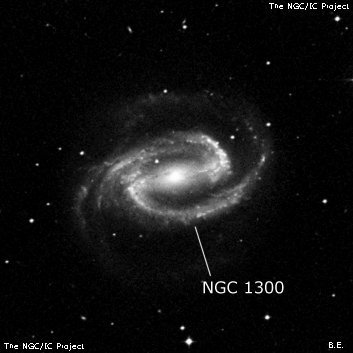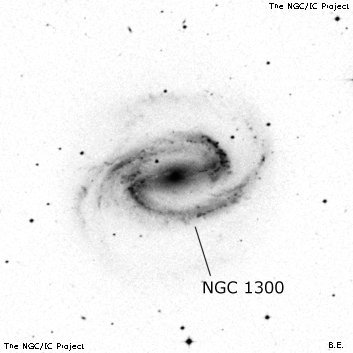NGC/IC Project Restoration Effort
(This is a very very beta version)
NGC1300


Basic Information
Location and Magnitude
Right Ascension: 3:19:40.7
Declination: -19:24:41
Constellation: ERI
Visual Magnitude: 10.4
Historic Information
Discoverer: Herschel J.
Year of discovery: 1835
Discovery aperture: 18.3
Observational
Summary description: cB, vL, vmE, psvmbM
Sub-type: SBbc
Steve's Notes
=====
NGC 1300
48" (10/25/14 and 10/29/16): the northern spiral arm is brightest and thickest in the 1' section, oriented SW-NE, where it attaches to the bar. At 375x and 488x at least three knots (HII complexes) were clearly resolved along this region. The brightest knot is on the southwest end (close to the end of the bar) and appears as a very faint, small, elongated glow, ~12"x8". This HII complex contains NGC 1300:[H69] 16/19 from Paul Hodge's 1969 "HII Regions in Twenty Nearby Galaxies" (ApJS, 18, 73). [H69] 15, the next brightest knot, is 0.3' NE and appeared very faint and small, ~8" diameter. Finally, [H69] 14, the faintest knot, is near the northeast end of this arm segment (~15" NE of [H69] 15) and is extremely faint and small, 6" diameter. The northern arm appears to fade out as it extends east (north of the core) but reappears along the eastern end of the arm.
The root of the southern arm at the east end of the bar is brighter and thicker, but no HII regions were resolved. The long southern arm can be traced the full length (nearly 4') sweeping west and arcing north on its western half. A small, weak knot is at the very tip, which is 2.5' W of center (on line with the bar).
30" (10/15/15 - OzSky): beautiful classic barred spiral at 303x! A prominent 3' bar runs WNW-ESE and contains a very bright, roundish 1' core that gradually brightens to the center. An easily visible arm is attached at the east end of the bar. It hooks sharply to the west on the south side, gradually curling towards the north. The arm has a fairly even surface brightness except where is attaches to the bar in a brighter, thicker section. It ends nearly due west of the core [2.2' from center]. An opposing arm attaches at the west end of the bar and is brightest initially along a clumpy section (containing at least 2 resolved knots) angling from southwest to northeast. The central section of the northern arm (directly north of the core) has a very low surface brightness but it brightens in a thin section near the east end. The two main arms extend at least 4.5'x3' ~E-W
48" (10/25/11): this prototype barred spiral was mesmerizing at 375x. Running roughly E-W through the center is a long bright bar, ~3' in length. The center is sharply concentrated with an intensely bright 1' core that continues to increase to a stellar nucleus. At the west end of the bar, a fairly bright arm emerges and hooks back dramatically to the east (counterclockwise) to the north of the bar and continues to the northeast end of the galaxy. The arm is brightest in a thick arc, oriented SW-NE, where it attaches to the bar. The central section of the arm to the north of the core is slightly fainter and then brightens slightly on its northeast end. A mag 15.5-16 star is superimposed in the gap between this arm and the core, 45" NE of center. The second arm emerges at the east end of the bar and is brightest initially in a fairly thick arc extending counterclockwise to the southwest. This arm is slightly more separated from the core as it gracefully curves to the southwest side of the galaxy. The two main arms increase the overall size of the galaxy to 5'x3' WNW-ESE.
17.5" (8/31/86): fairly bright, elongated ~E-W, bright core, stellar nucleus. A spiral arm is visible at the west end of the central bar curving to the north.
8" (10/13/81): faint, fairly large, elongated, low surface brightness, diffuse.



